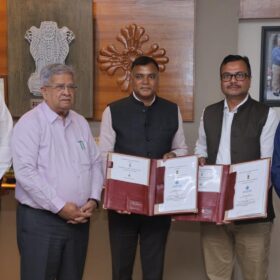A group of researchers led by India’s Sardar Vallabhbhai National Institute of Technology has designed a standalone solar-plus-storage system for use in the recharging of battery-powered road vehicles.
“The system is based on an advanced positive-pulse-current (PPC) battery charge control algorithm,” the research’s corresponding author, Ashish K. Panchal, told pv magazine, adding that it relies on hill-climbing PV maximum power point tracking (MPPT) to extend the battery life while utilizing maximum PV energy.
The proposed system uses two 40 W solar panels, two 12 Ah lithium-ion batteries, and two Ćuk converters. These converters are commonly used to transform a DC voltage at the input to a DC voltage at the output with reversed polarity.
The group explained that the Ćuk converters can ensure efficient power generation from PV panels, especially when the input voltage from the modules varies greatly due to changing sunlight conditions. “Since Ćuk converters have high voltage gain, they are excellent for PV systems that need varied voltage levels for different loads or battery charging because of their versatility,” it further explained. “Cuk converters also produce a smoother output voltage by efficiently controlling the output ripple current.”
In the proposed system configuration, the Cuk converters are coupled to the PV panels with the input ports, while the output ports are connected to the batteries. The system also utilizes a control system to integrate MPPT with battery charging.
The PPC charge control technique is used to charge the battery with the solar modules. It operates in three modes: PV with a single converter; PV with dual converters and in-phase operation; and PV with dual converters and out-of-phase operation. “Due to the fact that both converters are operating alternately when the system is operating out of phase, PV power is used more effectively,” the scientists explained. “However, when the system is operating in in-phase mode, both converters are idle at the same time, wasting PV power.”
Their analysis showed that the third mode can achieve a 100% utilization rate of the PV panels, while the percentage value for the other two modes is 50%. It also demonstrated that the out-of-phase PPC operation is the best option for charging the battery at a faster rate. Out-of-phase operation is executed when PV current is given to one battery in full at one time and another battery receives the full current from PV at the subsequent time.
“We successfully tested and validated the proposed charger through experimental hardware,” Panchal stated.
The academics described the system in the study “A standalone photovoltaic energy storage application with positive pulse current battery charging,” published in the Journal of Energy Storage.
This content is protected by copyright and may not be reused. If you want to cooperate with us and would like to reuse some of our content, please contact: editors@pv-magazine.com.









By submitting this form you agree to pv magazine using your data for the purposes of publishing your comment.
Your personal data will only be disclosed or otherwise transmitted to third parties for the purposes of spam filtering or if this is necessary for technical maintenance of the website. Any other transfer to third parties will not take place unless this is justified on the basis of applicable data protection regulations or if pv magazine is legally obliged to do so.
You may revoke this consent at any time with effect for the future, in which case your personal data will be deleted immediately. Otherwise, your data will be deleted if pv magazine has processed your request or the purpose of data storage is fulfilled.
Further information on data privacy can be found in our Data Protection Policy.